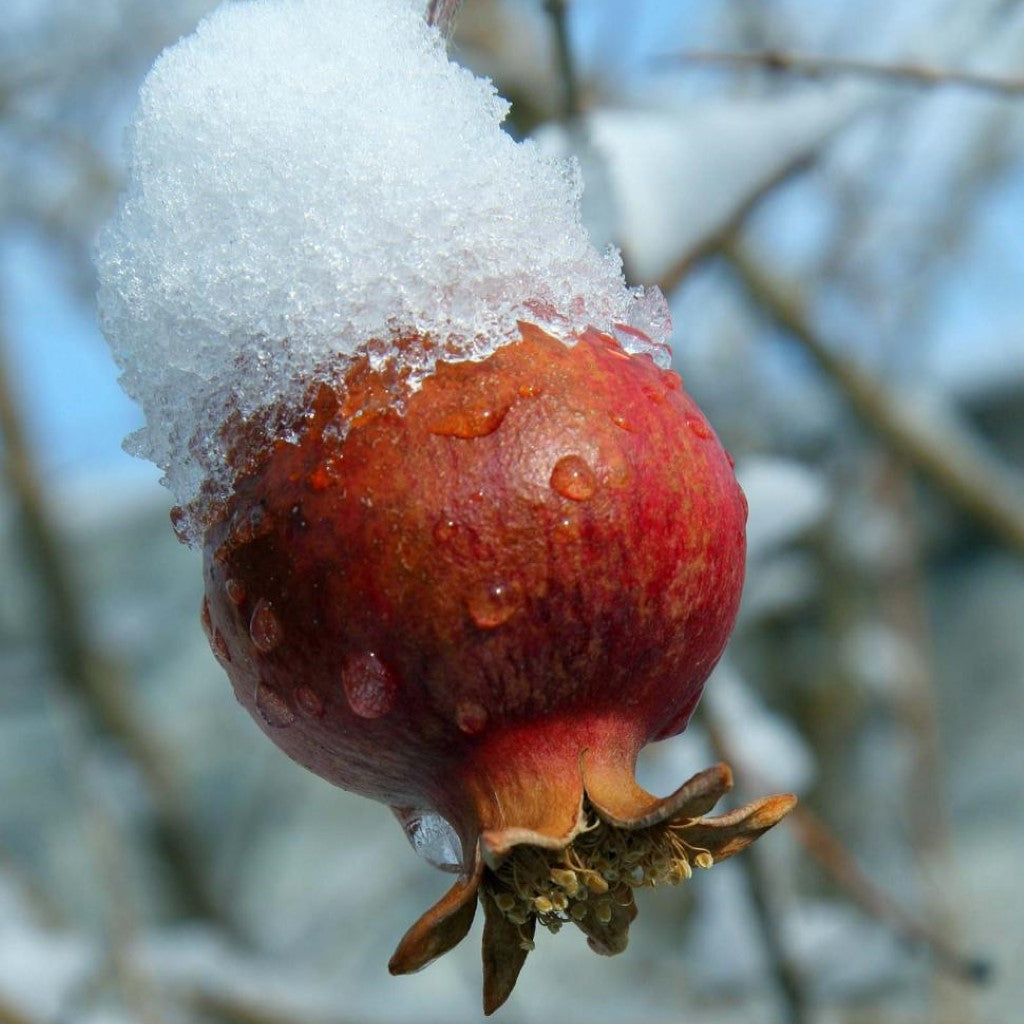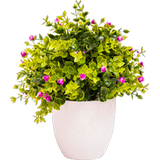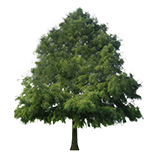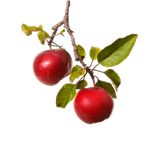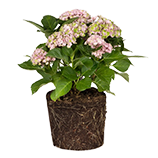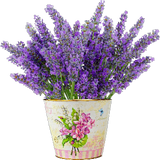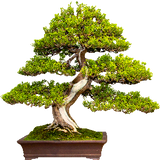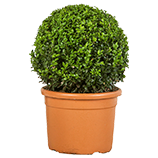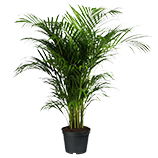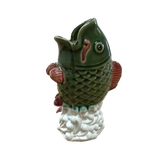
Description
🍀Salavatski Pomegranate Tree's Key Characteristics
Salavatski Pomegranate, a cold-hardy red pomegranate variety, stands out for its resilience in colder climates, making it a prized choice among cold-hardy pomegranate varieties. This cold hardy pomegranate tree is renowned for its ability to thrive in colder climates, distinguishing it among other pomegranate cultivars.
Among cold-hardy pomegranate varieties, the Salavatski stands out for its remarkable cold hardiness. It can withstand freezing temperatures, making it suitable for cultivation in USDA growing zones 7 to 10. This cold hardy red pomegranate tree exhibits robust growth, adding to its appeal for growers. It typically grows at a moderate pace, allowing for steady development and reliable fruit production.
🌳 Origin, Growing Conditions, and Optimal Habitat For Salavatski Pomegranate Tree
Salavatski Pomegranate, originating from the Salavat region in Russia, has earned its reputation as a cold-hardy pomegranate variety. The harsh winters of the Salavat region have influenced the resilience and adaptability of this remarkable fruit.
The Salavatski Pomegranate tree exhibits vigorous growth, reaching heights of 15 to 20 feet with a spread of 12 to 15 feet under optimal conditions. Its growth rate is moderate, allowing for steady development and fruit production. This variety thrives in regions with a Mediterranean climate, characterized by hot, dry summers and mild winters.
More details about this cold hardy Salavatski is given in the table on the right.
✨Care and Maintenance of Cold Hardy Salavatski Pomegranate Tree
Caring for your Salavatski Pomegranate tree is essential to ensure its health, vitality, and fruitful harvests. Follow these guidelines for proper care and maintenance:
- Site Selection: Choose a sunny location for your Salavatski pomegranate tree, as it thrives in full sun. Ensure the soil is well-drained to prevent waterlogging, which can lead to root rot.
- Watering: Provide regular watering, especially during the tree's establishment period and dry spells. Once established, Salavatski pomegranate trees are drought-tolerant but benefit from occasional deep watering during prolonged dry periods.
- Fertilization: Apply a balanced fertilizer in early spring before the growing season begins. Use a fertilizer formulated for fruit trees, applying it according to the manufacturer's instructions. Avoid excessive nitrogen fertilization, as it can promote excessive vegetative growth at the expense of fruit production.
- Pruning: Perform annual pruning during the tree's dormant season to maintain its shape and encourage fruiting. Remove dead, damaged, or crossing branches to improve airflow and sunlight penetration. Prune to open up the canopy, allowing for better fruit development and harvesting ease.
- Pest and Disease Management: Monitor your Salavatski Pomegranate tree regularly for signs of pests or diseases, such as aphids, fruit borers, or fungal infections. Control pests using organic or chemical methods as necessary, following recommended guidelines. Maintain good air circulation around the tree and avoid overhead watering to reduce the risk of fungal diseases.
- Mulching: Apply a layer of organic mulch, such as wood chips or compost, around the base of the tree. Mulch helps retain moisture, suppresses weed growth, and adds organic matter to the soil as it breaks down.
🔎 Searching For "Where to Buy Salavatski Pomegranate Tree Near Me"?
If you're looking to add the cold-hardy and flavorful Salavatski Pomegranate to your garden or orchard, look no further than Pixies Gardens. As a leading provider of high-quality fruit trees and plants, Pixies Gardens offers a wide selection of Salavatski Pomegranate trees, ensuring that you can find the perfect specimen for your growing needs.
💡 Frequently Asked Questions (FAQs)
1. What is the fruit of Salavatski pomegranate?
The fruit of the Salavatski Pomegranate is renowned for its exceptional flavor and vibrant color. Salavatski Pomegranates produce large, round fruits with deep red arils inside. These arils are packed with sweet-tart juice and antioxidants, offering a delightful burst of flavor and rich nutritional content. At Pixies Gardens, you can find high-quality Salavatski Pomegranate trees, ensuring that you can enjoy the delicious fruits of this cold-hardy variety in your own garden or orchard.
2. Which is the best variety of pomegranate?
While opinions may vary depending on personal preferences and growing conditions, the Salavatski Pomegranate is widely regarded as one of the best varieties of pomegranate, particularly for its cold-hardy nature and exceptional fruit quality. At Pixies Gardens, we offer a selection of top-quality pomegranate varieties, including the Salavatski, ensuring that you can find the perfect variety to suit your specific needs and preferences.
3. Where is the best pomegranate in the world?
The best pomegranates in the world are often found in regions with a Mediterranean climate, where the hot, dry summers and mild winters provide optimal growing conditions for this fruit. Countries such as Turkey, Iran, and Spain are renowned for their high-quality pomegranates, prized for their exceptional flavor, color, and size. At Pixies Gardens, we strive to bring the best of these world-class pomegranate varieties to our customers, ensuring that you can enjoy the finest quality fruits right in your own backyard.
4. What is the most sweet pomegranate?
While sweetness can vary depending on factors such as growing conditions and ripeness, the Wonderful variety is widely regarded as one of the sweetest pomegranates available. This variety, known for its exceptionally sweet and juicy arils, is a favorite among pomegranate enthusiasts and is prized for its delicious flavor and nutritional benefits. At Pixies Gardens, we offer a selection of top-quality pomegranate varieties, including the Wonderful, ensuring that you can enjoy the sweetest and most flavorful fruits in your own garden or orchard.
Average US Salavatski Tree Growing Zones:

| Parameter | Details |
|---|---|
| Family | Lythraceae |
| Growth Habit | Deciduous tree |
| Height | Typically 15 to 20 feet (4.5 to 6 meters) |
| Lifespan | 20 to 30 years in optimal conditions |
| Hardiness Zones | USDA Zones 7 to 10 (tolerant to cold temperatures) |
| Temperature (F) | Thrives in a range between 40°F to 85°F (4°C to 29°C) |
| pH Range | 5.5 to 7.5 |
| Sun Exposure | Full sun |
| Watering Needs | Moderate; drought tolerant once established |
| Pruning Requirements | Annual pruning during dormancy to shape the tree and remove dead or crossing branches |
| Flowering Season | Late spring to early summer |
| Flower Color | Vibrant red or orange |
| Fruit Ripening Season | Late summer to early fall |
| Fruit Color | Deep red arils |
| Fruit Flavor | Sweet-tart, with a rich and refreshing taste |
| Propagation Methods | Grafting or hardwood cuttings |
| Pests and Diseases | Relatively resistant to pests and diseases; occasional issues with aphids or fruit borers |
| Harvesting Time | When fruits achieve a deep red color and feel heavy for their size |
| Fertilizer Information | Apply a balanced fertilizer in early spring and again in early summer. Use organic matter to improve soil fertility. Avoid excessive nitrogen fertilization to prevent excessive vegetative growth. |


